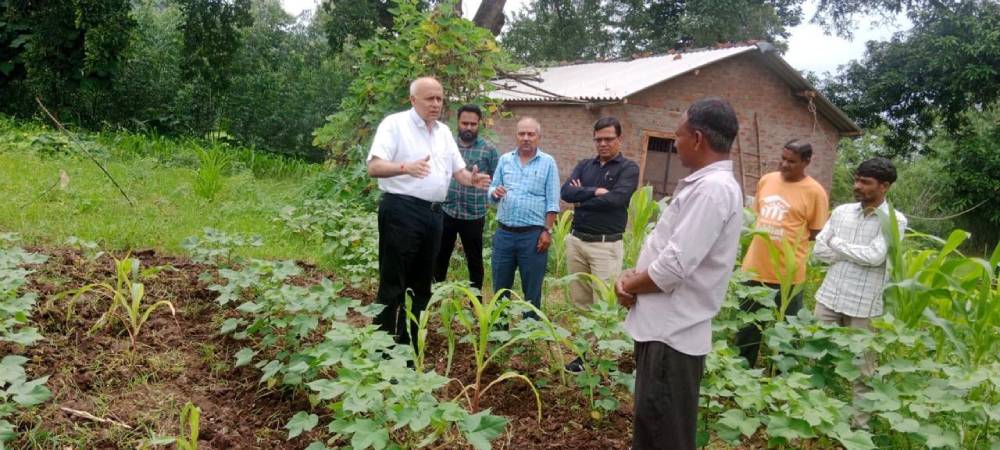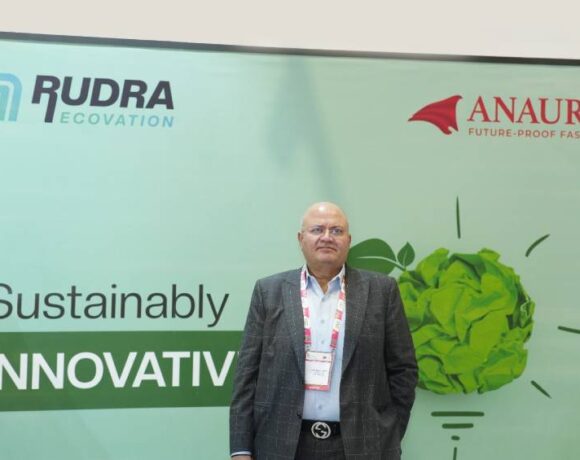‘Transition To Organic Fibre Production Presents New Opportunity To Enhance Sustainability In Cotton Textile Industry’ :Dr Ajay Ranka

For profitable transition to organic cotton production, collaborative efforts involving government, banks, financial institutions and stakeholders in the textile industry are essential, says Dr. Ajay Ranka, Chairman & Managing Director, Zydex Group in an exclusive tete-e-tete with Henry Dsouza, Associate Editor of Textile Insights.
What are the main barriers hindering the widespread adoption of organic cotton farming in India and how do you suggest overcoming them?
The primary barriers to widespread adoption of organic cotton farming in India are multifaceted. Firstly, it’s crucial to understand that transitioning to organic cotton cultivation necessitates dedicating the entire land exclusively to organic practices throughout the year. For instance, if a farmer chooses organic certification for cotton, the challenge arises with subsequent crops. Unless both crops are economically viable for the farmers, they are unlikely to opt for organic farming.
Secondly, India’s agricultural landscape has been heavily reliant on chemical fertilizers and pesticides over the past five decades. Consequently, soil health and biological diversity have suffered. Organic farming relies heavily on robust soil health and thriving biological activity, which poses a significant challenge when transitioning from degraded soil and weakened biology. This often results in lower yields during the initial transition period, discouraging farmers who demand immediate returns on their investment.
Furthermore, there is a disparity between the reluctance of industries to pay premium prices for organic cotton and the farmer’s inability to immediately increase yields. Many natural farming practices integral to organic cultivation require significant time—often up to five years—to restore soil fertility. However, farmers are unwilling to accept such a prolonged transition period.
Another critical bottleneck is the heavy reliance on animal manure resources in natural farming practices. India lacks sufficient livestock to sustainably meet the demands of current organic farming practices on a large scale. Consequently, the current organic farming practices may not be feasible or sustainable across the entire agricultural landscape.
This indicates that the current practice of organic farming is not sustainable in terms of the resources required for the entire landmass. Consequently, many farmers will be unable to pursue it even if they desire to do so.
Could you share with us some insights about the most specific challenges in India’s conventional cotton industry that led you to focus on transitioning to organic fibre production?
The specific challenges in India’s conventional cotton industry that led me to focus on transforming it to organic fibre production are multifaceted. Firstly, India’s textile exports primarily comprise cotton or viscose-dominated apparels and home textiles, where maximum value addition occurs. With the global demand for organic cotton rising, there’s a growing desire for India to supply organic cotton textiles due to its potential for high value addition.
India’s favourable climate and large arable land make it a promising candidate for organic cotton cultivation. The country’s conducive soil temperature of 15 to 32 degrees, abundant rainfall of 100 cms which means 40-45 lakh litres of water per acre per year and ample sunlight provide ideal conditions for efficient biological processes that are crucial in organic farming. The robust population of new generation of beneficial microbes and technology to enhance biological activity in Indian soils further makes it possible for a successful transition to organic cultivation.
Moreover, innovations like the Prakalp Sanjivani protocol developed by Zydex offer solutions to rejuvenate degraded soils and promote organic farming practices efficiently. By leveraging such methodologies and supporting products, India has the opportunity to transition towards chemical-free and eventually organic cotton production.
With these factors, the transformation to organic fibre production presents an opportunity for India to not only meet global demand but also enhance sustainability and profitability in its cotton industry.
How do you propose creating value propositions that justify the higher costs associated with organic cotton production to consumers and downstream stakeholders?
The biggest change we’ve brought is the assurance of similar or even better profitability through organic cotton farming. This eliminates the need for farmers to expect higher prices immediately. However, by exporting organic cotton and realizing higher returns, our producers and exporters may naturally be willing to pay more. Ultimately, if we can consistently produce entire quantities of cotton with supply assurance, exporters will gain confidence in assuring the international market of our reliability. The market will then determine the premium they’re willing to pay. Even if we receive the same price, neither farmer nor exporter is losing money in transitioning to organic farming. What’s more, we’re ensuring the long-term fertility of our soils by avoiding degradation. This Zytonic approach also reduces water requirements by up to 40-50%, allowing our lands to recharge and reverse water table depletion. Moreover, by eliminating poisonous crop chemicals, we’re creating toxin-free soils for subsequent food crops. Thus, while we aim for higher profits, our focus is on sustainability and ensuring that benefits are sustainable in long term.
Will end consumers pay a premium price for organic cotton?
There is a significant class of consumers, estimated between 100 million to 500 million, who prioritize sustainability and are willing to pay for organic products. However, the key concern lies in providing assurance regarding the authenticity of organic cotton. Currently, many consumers remain unsure if products labeled as organic truly adhere to organic standards. By building trust and assurance within the system, we can tap into this consumer segment willing to pay a premium. Transitioning and educating a crore farmer base is the challenge.
While it’s unlikely that all 8 billion people on the planet will opt for organic products immediately, societal shifts and growing awareness may lead to increased demand over time. Even if this transition takes several years, there is potential for consumer attitudes to evolve, especially as incomes rise. A modest premium, say 10%, is feasible and acceptable to consumers, considering its minimal impact on the overall cost of garments. Thus, by providing transparency and assurance, we can capture the willingness of consumers to pay extra for organic cotton and make India synonymous with “Organic Cotton”

How do you assess the financial viability of transitioning to organic fibre production, and what strategies do you recommend for mitigating financial risks?
The primary challenge lies in the upfront investment required, typically ranging from Rs 5,000 to Rs 7,000 per acre, to kick-start soil fertility improvement under the new protocol. Farmers often hesitate due to the perceived financial risks, especially if water scarcity affects crop yields.
To mitigate these risks, collaborative efforts involving government, banks, financial institutions and stakeholders in the textile industry are essential. Establishing support mechanisms that underwrite the initial investment for farmers, particularly in designated clusters, can alleviate financial concerns and encourage adoption. Educating and demonstrating benefits to the farmer is a key to successful transitioning since it is profitable now.
It’s crucial to emphasize the long-term benefits and potential cost savings associated with transitioning to organic practices. For instance, the cost of preserving soil fertility and water resources over the next few decades far outweighs the initial investment required. By highlighting these economic and environmental advantages, stakeholders can build confidence and momentum for widespread adoption.
Moreover, offering incentives and rewards for successful transition projects can incentivize farmers and demonstrate the financial viability of organic farming. Publicizing success stories and providing access to resources and expertise further encourage participation and mitigate perceived risks.
Further, I offer an open challenge to the farmers and esteemed agricultural scientists. Let’s put Zydex’s organic farming methods to the test against conventional chemical practices. I will offer a bet of Rs 1 lakh per acre to be accepted by both parties to demonstrate their approach. If our biological methods outperform the chemical ones, the prize is ours. Otherwise, the challenger takes home the reward. This challenge is to just demonstrate our confidence in Zydex’s innovations and data with our commitment to advancing sustainable agriculture.
Supply chain management plays a critical role in ensuring the integrity and traceability of organic cotton products. What measures do you advocate for establishing robust supply chain systems to maintain quality standards and meet market demand?
Establishing robust supply chain systems for organic cotton products requires a multifaceted approach. Firstly, it’s imperative to conduct regular soil health assessments on organic farms to monitor organic carbon content, nutrient levels and detect any unauthorized pesticide use. Additionally, implementing Cation Exchange Capacity (CEC) and salinity monitoring can further enhance soil quality management. Secondly, periodic pesticide residual analysis at the end of crop cycles ensures organic compliance and builds trust in the farming practices.
To maintain traceability and quality standards, I propose the adoption of QR code technology for certified organic farms. Each farm could be assigned a unique QR code, linking it to the inputs used and the resulting outputs. This would enable easy identification and verification of organic practices during certification audits. Furthermore, government involvement could mandate QR codes on certified organic inputs, facilitating traceability from farm to manufacturer.
With the widespread use of mobile technology, QR code scanning is accessible and efficient, allowing seamless integration into supply chain management. By leveraging these technological advancements, the industry can ensure transparency and accountability throughout the organic cotton supply chain. While implementing such measures may require initial investment, the long-term benefits in terms of traceability and consumer trust outweigh the costs.
Scaling up production to meet growing demand for organic cotton presents logistical challenges. What strategies do you propose for expanding production capacity while maintaining quality control and operational efficiency?
India’s population growth appears to be stabilizing, suggesting a slowdown in food demand. Therefore, with no choice left, our focus must shift towards exporting more agricultural products, whether it’s sugar, cotton, fruits or vegetables. The future of agriculture lies in exports. My intuition tells me that if we can position organic cotton as a flagship product of Brand India, we’ll have a winner. Encouraging more farmers to cultivate cotton organically could lead to increased exports and added value for our citizens.
I believe that transitioning to organic cotton production could yield a premium of 15-25%. If even half of this premium is passed on to the farmers, they would be incentivized to switch to organic cultivation and expand their land under cultivation. Additionally, reducing water consumption in cotton farming could significantly improve yields, especially in rain-fed areas. This would enhance cotton availability in the future and contribute to India’s prosperity. That’s my estimation.
What message you want to convey to the industry regarding organic cotton production in India?
We’re a company led by a technocrat, asserting that profitable organic cotton production is achievable in India at market prices. This transition can occur within a single crop cycle, conserving water and enhancing India’s soil fertility, ensuring our long-term status as a global cotton supplier. The potential exists to convert India’s entire cotton production to organic, marking a significant brand-building opportunity worldwide. My appeal to every stakeholder — developed locally, this technology offers a unique advantage. Seize this opportunity! Investigate, experiment and, if proven true, implement, support and drive this initiative forward!















